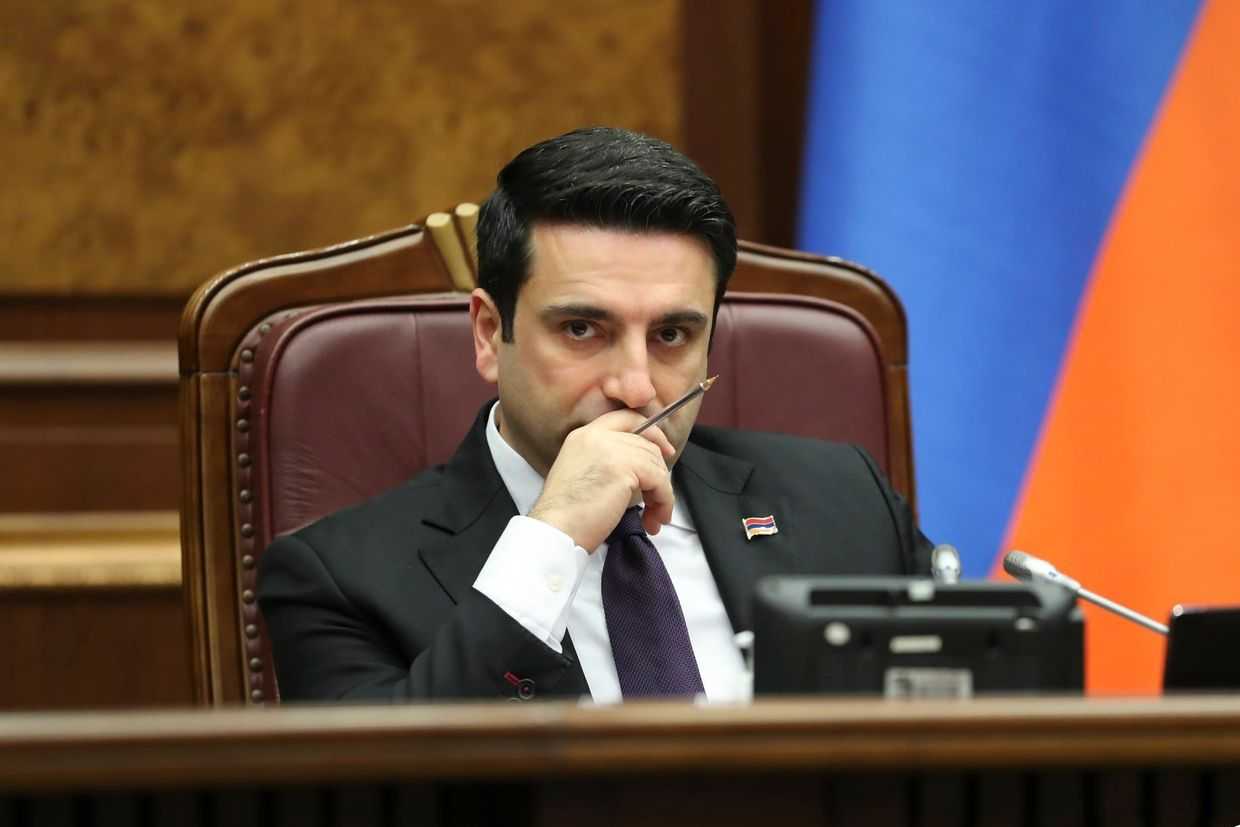
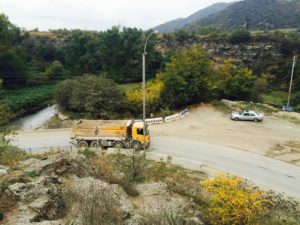
GeoProMining is an international precious metals mining company. It was founded by Russian businessman Siman Povarenkin, with a local partner in Georgia, Koba Nakopia. The company has damaged environments in Georgia, Armenia, and Russia while mining gold and other precious metals.
Thanks to close contacts in local governments, the gold mining enterprise and its subsidiaries have never been seriously penalised. Local governments either don’t investigate major environmental pollution incidents or they don’t publish the investigation results.
#Kazreti, Georgia. Air pollution
In the small town of Kazreti, Bolnisi region, around 4 km away from the Sakdrisi mine, dozens of trucks loaded with ore drive towards the nearby copper ore processing factory every day. The truck route is covered with the thick layer of dust. Road signs, abandoned junk cars, village bus stop kiosks — all are covered in a thick layer of yellow dust.

Rich Metals Group — the company which is mining gold and copper in the area — is obligated to spray water on roads in order to reduce dust. The local population claims the company seldom or never does it.

The National Environmental Agency does not estimate the particles of ore in the air in Kazreti, so there is no specific data about it.
The company is also not measuring these particles as part of its self-monitoring process. There is no such data in an incomplete self-monitoring report provided to the Ministry of Environment and Natural Resources Protection by the Rich Metals Group.
Water and soil contamination

On 24 February 2014, the River Kazretula was contaminated as a result of emergency discharge of 500 cubic meters of acidic industrial waters. Waters were released from the so-called ‘thickener reservoir’ (with a volume of 5,000 cubic meters), located on JSC Rich Metals Group Copper’s property near its mineral resources processing factory.
This contamination is confirmed by an official document issued by the Environmental Protection Supervision Department on 27 February 2014.
On that same day, representatives from the Environmental Protection Supervision Department visited the factory where copper concentrate is produced. Representatives also took water samples from the Mashavera and Kazretula rivers downstream.
‘Contamination of the Mashavera River was detected near the confluence of the Kazretula and Mashavera rivers near the village of Chapala’, stated the pollution report.
According to the samples, near the confluence of the two rivers the zinc concentration exceeded the acceptable norm set by Georgian law by 220.4 times; for manganese, 479 times; for copper, 157.1 times; for iron, 36.4 times.
The report issued by the National Environmental Agency shows that in addition to the heavy metals water contamination, there was a fish kill. The report included eyewitness testimonies of three local citizens speaking about what they saw on the day the contamination occurred.
‘Hereby I confirm, that on 10 February 2014 at 10:30 I was present in village Chapala, Bolnisi region. While crossing the bridge on river Mashavera, I noticed dead fish along the river banks and collected them.
‘Since the river had a strange color and a sharp smell everywhere, I had a suspicion that the fish were not edible, so I threw them out. I noticed people around the river banks, also gathering fish, and advised them not to use them for eating, as they appeared to be poisoned’ — letter signed by eyewitness Zurab Liparteliani.
There are two similar letters attached to the report, signed by Vladimir Rekhviashvili and Beso Rekhviashvili.
‘There was an acidic environment discovered in the River Kazretula that caused increased solubility of heavy metals and amplified their concentration in water. Strong acidic environment in the water may negatively affect biodiversity in many ways. In particular — harm or eliminate certain species of fish, reduce fish population, endanger certain fish species, etc.’ — the agency report states.
Using a special formula, which according to Georgian law defines the damage caused to the environment, the National Environmental Agency calculated the environmental damage at ₾1,078,187.96 (about $452,000 at today’s rates).
Court rejection of access to information about the pollution investigation
On 21 March 2014, the then-chief at the Environmental Protection Supervision Department Irakli Mukniashvili sent case details to then-Prosecutor Giorgi Badashvili, and urged further investigation.
Three years have passed. In October of 2016, a request was sent to the prosecutor’s office asking whether an investigation had started and if so what was its status.
The prosecutor’s office replied that they were not obligated to answer those questions as they are not categorised as public information.
The Ministry of Environment and Natural Resources Protection did comment, stating that they did not have any information about any active investigation. The Ministry only specified that one of their employees was questioned regarding the case in 2014.
An appeal was filed against the prosecutor’s response, stating that the requested information concerns the environment and thus is public according to Georgian legislation, as well as the Aarhus Convention, to which Georgia is a signee.
Tbilisi City Court Judge Khatia Ardazashvili denied the appeal, citing the 3rd article of the General Administrative Code of Georgia and stating this was not categorised as publicly accessible information.
‘As long as the information requested by the claimant is regulated with the Criminal Procedure and is a part of execution of prosecution’s managerial function, accordingly, applying the 3rd article of General Administrative Code of Georgia to this case lacks legal basis’, stated the judge’s decision. ‘Claimant’s request was properly rejected by the Prosecutor’s Office of Georgia, as the Prosecutor’s Office of Georgia was not obligated by the law to give away the information of such content. Therefore the complaint lacks legal reasoning and should not be satisfied.’
The prosecutor’s office has a discretionary right to release information about a case during the investigation process. Attorney Sulkhan Saladze, who argued the appeal on behalf of journalists, said such release of information has occurred in the past. Saladze stated that in this case, the prosecution acted selectively in not providing information.
During the court hearing, prosecutor’s office representative Ana Kapanadze stated several times that if prosecution gave out the information, it would harm specific individuals. When asked by Saladze who would be harmed specifically, Kapanadze did not appear to be willing to answer.
‘I cannot say. I did not investigate this specific case at our office’, replied Kapanadze.
#Agarak, Armenia
Armenian environment activists have solid proof that GeoPromining’s subsidiary gold mining companies are damaging the environment with solid and liquid waste.
Liquid waste contaminated with heavy metals flows into the River Kharchevan and thus reaches the River Araks, which flows into Iran from Armenia, creating the threat of cross-border pollution.
Contamination on 8 November 2016
On November 8, 2016 the coordinator of the Armenian Environmental Front Levon Galstyan witnessed a thick manufacturing spill from the local gold mining company flowing into Kharchevan River. Galstyan recorded video of the spill and distributed the visual proof.
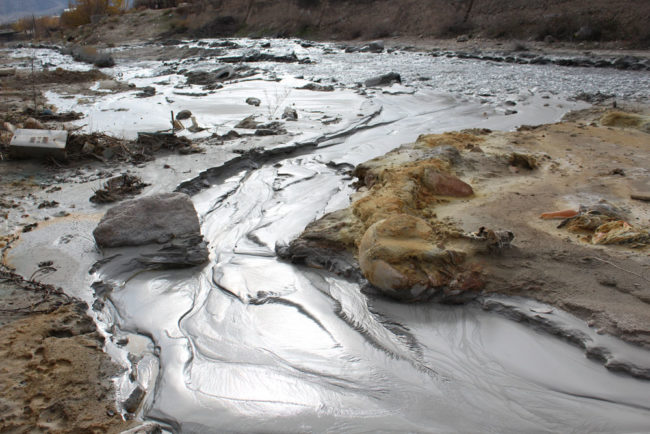
The non-governmental organisation spread the video and requested reaction from the government. The Ministry of Nature Protection of Armenia announced that they had contacted the company and was proceeding with administrative litigation over this pollution case.
No information was shared on the webpage of GeoProMining regarding the case.
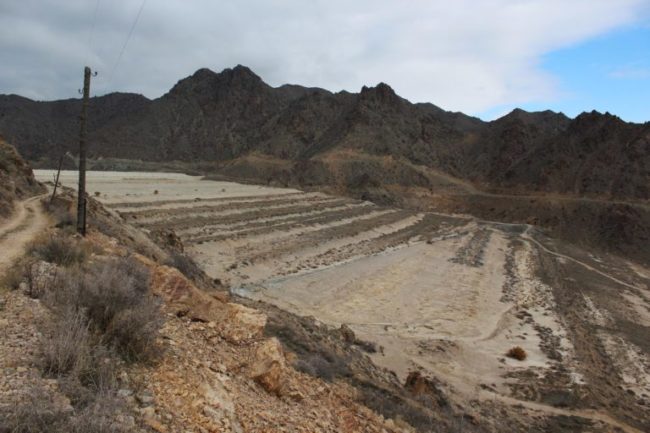
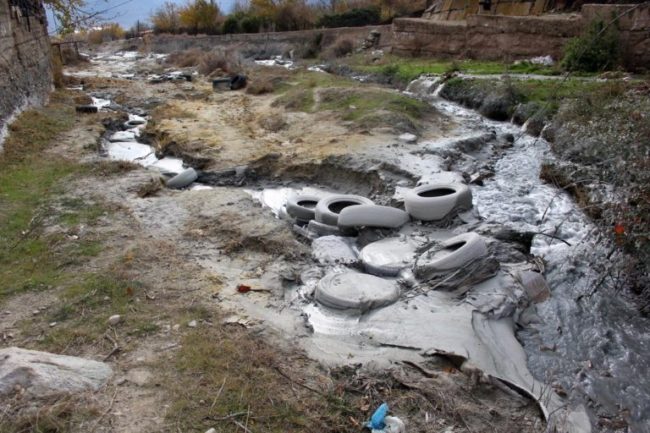
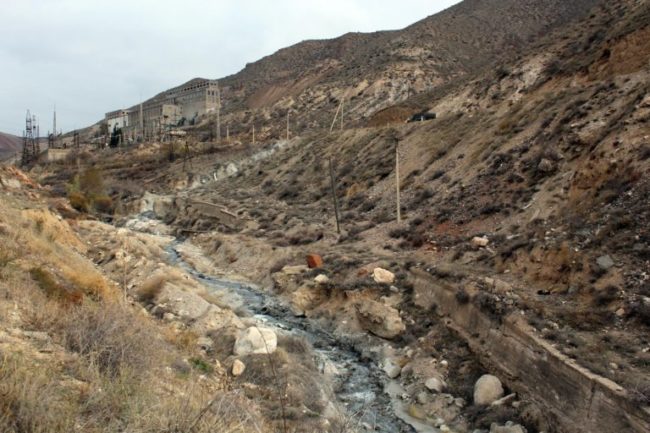
At the end of last November, the Ministry of Nature Protection denied the fact that the company’s liquid waste appeared in the river. The Ministry declared that they would conduct laboratory tests on the water and would later publish the results.
The Armenia news and investigative website Hetq — contacted the Ministry of Nature Protection and asked for the public information — the laboratory test results. The ministry responded that the tests were yet not completed and they couldn’t provide any results at that time. Later, the ministry declared that the environmentalist’s information did not correspond to the truth.
‘This liquid is nothing other than muddy water’, declared the head of public relations of the Ministry of Nature Protection to the Hetq journalist.
Hetq repeatedly requested official laboratory test results from the ministry. The ministry again did not present laboratory test results, and their answer to the second letter was identical to the previous one — that the liquid was ‘muddy’ and not in fact a substance contaminated with heavy metals.
Two weeks from the incident, Hetq journalist Hrant Galstyan visited the Agarak ore processing factory. Despite the fact that the water exiting the pipe was no longer golden, traces of liquid was left in surrounding rock formations and on tires thrown in the River Kharchevan.
The journalist saw how the new stream of toxic liquid was flowing from the Agarak factory down the valley of the River Kharchevan. The liquid was not transparent.
According to locals, it was most likely industrially contaminated water.
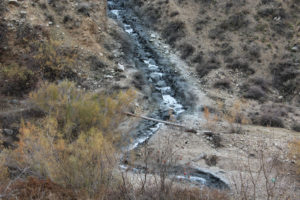
Toxic liquid first reaches the River Kharchevan and later reaches the River Araks, which crosses Agarak town and flows into Iran.
There were still some solid golden sediments to be found near the town.
Alongside the road near the River Kharchevan there are residential houses and agricultural fields. The local population says that due to fears of food contamination, they currently avoid using the river water for irrigation.
Hetq had been repeatedly reporting through the years that the local population had been using water from this river to irrigate fields. Even if the population of Agarak is not currently using the River Kharchevan for irrigation, they are getting water from the River Araks, which is also contaminated by the waste from fluids flowing down from the factory.
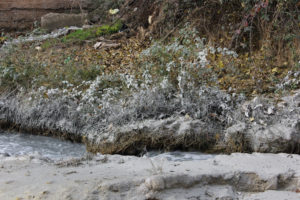
The local population does not speak about this openly. Despite acknowledging that the factory has a bad influence on local air, water and soil, they don’t want to see their names in media stories, for fear their family members or relatives working in the factory might lose their jobs.
There are 300 households in the village of Kharchevan, not far from the mine. Most of the families have at least one member working for the company.
The Agarak ore mining complex owns one of the biggest quantity of tailings (ore residue) in Armenia. In 2012 they accumulated 43 million cubic meters of waste. The biggest site, which can store up to 40 million cubic meters of liquid waste, is located near the River Darazami.
In 2016 the American University of Armenia conducted research which included testing soil and drinking water in Agarak. The water quality of the River Kharchevan downstream of Agarak town corresponds to Bad (V) class by iron, nickel and copper.
With respect to soil, out of five tested metals, arsenic concentration exceeded the acceptable norm by 14.6 times, while copper exceeded the norm by 43.5 times.
#Yakutia, Russia
In Yakutia, also known as Sakha Republic, JSC ‘Sarilakh-Surma’ is mining ore that contains gold. The company is 100%-owned by GPM Russia B.V. , which is registered offshore. JSC ‘Sarilakh-Surma’ is managed by GeoProMining Ltd. Siman Povarenkin is on both boards of directors.
In 2012, Russian ecologists were reporting that “Sarilakh-Surma” violated the regulations for storing ore materials not following the rules. Earlier, on July 2, 2008, the Ministry of Natural Resources and Environment of the Russian Federation published a list of the administrative law violator companies on their website, giving detailed descriptions of the nature of each violation.
According to the ministry, at the exact location where ore was stored, the concentration of antimony in the soil exceeded the country’s legal norm by 1.8 times. This pollution was listed as violation of storage regulations for antimony concentrate and resulting soil contamination.
Magadan region department representative of Ministry of Natural Resources and Environment of the Russian Federation sent us a written response, stating that the company paid the penalty.
‘Considering that the period of time, within which an individual or a company is considered to be an administrative law violator, we find it unnecessary to provide any additional information’, replied the representative of Magadan Oblast for the Department of Ministry of Natural Resources and Environment.
Company connections with local politicians
In 2015 during local elections, «ГеоПроМайнинг Верхнее Менкече» Ltd. transferred ₽4 million to Yakutia mayor Yegor Borisov’s election campaign fund. The case got a lot of local media coverage.
Money transfer itself is not against Russian law. «ГеоПроМайнинг Верхнее Менкече» Ltd.is registered in The Netherlands and is owned by Karlou B.V. and GPM Russia B.V. — a local gold mining company which operates in Magadan and was planning to construct a new factory in Degtyarsk.
Project of a new factory in Degtyarsk
The launch of construction of a new factory by ‘National Antimony Company’ in Degtyarsk, Yekaterinburg was followed by major protest demonstrations. Degtyarsk is a town in Sverdlovsk Oblast with a population of 16,000.
50% of the factory is owned by Гринпроджект Ltd., founded by Siman Povarenkin and his Russian partner Roman Khudol. At the end of 2014, a 50% share of the company was purchased by Igor Rotenberg, who is listed in the top five company owners who get the biggest share of Russian government orders, according to Forbes Russia.
‘National Antimony Company’ Ltd. didn’t suffer from a lack of attention from the government either. In 2015, the Ministry of Industry and Trade of the Russian Federation included it in the list of companies who are receiving funds from state budget so that they could pay back credits taken from commercial banks in 2014–2016 and invest in big infrastructure projects.
The Degtyarsk factory would have produced 5,700 tons of antimony trioxide per year, which implied processing 10,000 tons of antimony concentrate daily. With this kind of production, the company could meet the demand for the product in Russia and additionally enter the markets of Belarus and Kazakhstan. The ore would have been extracted from the Yakutia mines.
The company, owned by Siman Povarenkin, planned to invest ₽700 million (about €10 million) in the venture.
The local population took the factory construction news very negatively. They repeatedly held protest demonstrations. Their main concerns were that the factory was to be constructed near residential houses, and that two big reservoirs located nearby which provided Yekaterinburg with water for 1.4 million people.
According to Russian regulations, the company was obliged to arrange public discussions and including the local population of Degtyarsk. The local population and ecologists demonstrated three times during the process. Resistance continued for two years.
In 2015, as a result of pressure applied by the local population, the local government acknowledged the project as dangerous for people and the environment and did not issue the permission to commence it.
The article was written by Tsira Gvasalia, Hrant Galstyan, and Alisa Kustikova. It was originally published on Golden Dust on 26 April 2017.





